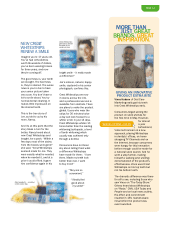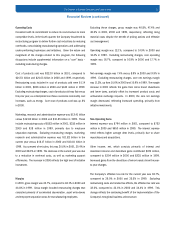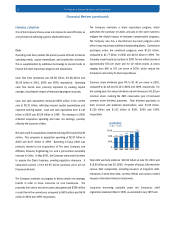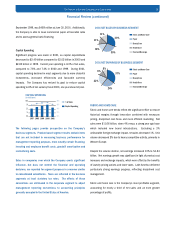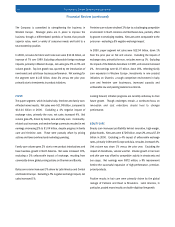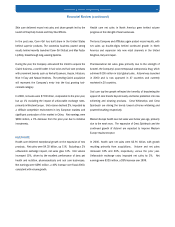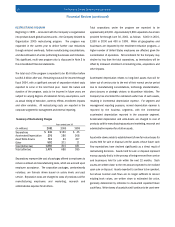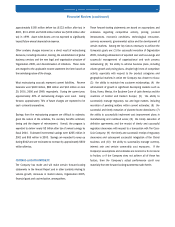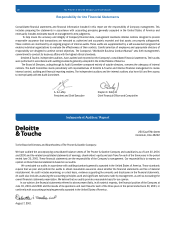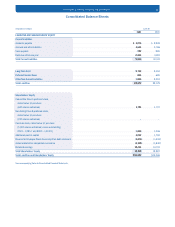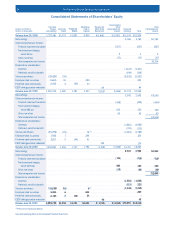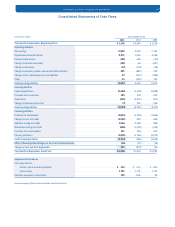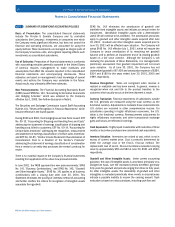Proctor and Gamble 2001 Annual Report Download - page 18
Download and view the complete annual report
Please find page 18 of the 2001 Proctor and Gamble annual report below. You can navigate through the pages in the report by either clicking on the pages listed below, or by using the keyword search tool below to find specific information within the annual report.
CORPORATE
The corporate segment includes both operating and non-operating
elements such as financing and investing activities, goodwill
amortization, employee benefit costs, charges related to
restructuring, segment eliminations and other general corporate
items.
Corporate includes adjustments from management reporting
conventions to conform with accounting principles generally
accepted in the United States of America. These primarily affect the
treatment of unconsolidated investees and income taxes, which are
reflected in the business segments using applicable local statutory
tax rates.
Corporate results reflect one-time gains from the Company’s non-
strategic brand divestiture program, increased restructuring costs,
reduced overhead spending and corporate hedging gains, partially
offset by higher employee benefit costs, and certain tax impacts not
reflected in the business segments.
HEDGING AND DERIVATIVE FINANCIAL INSTRUMENTS
The Company is exposed to market risks, such as changes in interest
rates, currency exchange rates and commodity prices. To manage
the volatility relating to these exposures, the Company nets the
exposures on a consolidated basis to take advantage of natural
offsets. For the residual portion, the Company enters into various
derivative transactions pursuant to the Company’s hedging policies.
The financial impacts of these hedging instruments are offset in part
or in whole by corresponding changes in the underlying exposures
being hedged. The Company does not hold or issue derivative
financial instruments for trading purposes. Note 6 to the
consolidated financial statements includes a discussion of the
Company’s accounting policies for financial instruments.
FOOD AND BEVERAGE
Food and beverage results were below year ago, as strong sales and
earnings in coffee were offset by soft snacks and juice results. Net
sales were $4.14 billion, down 11%. Excluding a 1% impact of
divestitures and a 2% unfavorable foreign exchange impact, net
sales declined 8%. Unit volume declined 10% including a 2%
impact from divestitures. Unit volume was negatively affected by
reduced trade merchandising and snacks pricing actions in North
America and Western Europe, and the divestiture of institutional
shortening and oils. Net earnings were $333 million, down 9%
versus last year.
The coffee business had a record year with Folgers achieving its
strongest volume increase in a decade.
In snacks and juice, North America results are showing signs of
stabilizing as merchandising returned to competitive levels. Lower
net earnings in Western Europe were primarily due to investments in
Sunny Delight and the impact of a strong U.S. dollar.
During the year, P&G and The Coca-Cola Company announced the
intent to form a new venture to maximize the growth potential of the
snacks and juice business on a global basis. Both parties are
committed to completing a mutually-agreed transaction; however,
the parties anticipate that any transaction will likely contain terms
different from those announced previously. The Company also
separately announced its intent to explore strategic options for its
peanut butter and retail shortening and oils business.
In 2000, net sales were flat versus the prior year at $4.63 billion,
including a 1% negative exchange impact. Unit volume also was
flat. Excluding the 1999 divestiture of Hawaiian Punch, unit volume
increased 5% behind strong growth in Western Europe and
Northeast Asia, partially due to the expansion of Pringles. Net
earnings increased to $364 million, up 11% versus the previous
year, primarily due to gross margin improvement.
The Procter & Gamble Company and Subsidiaries
16
Financial Review (continued)





